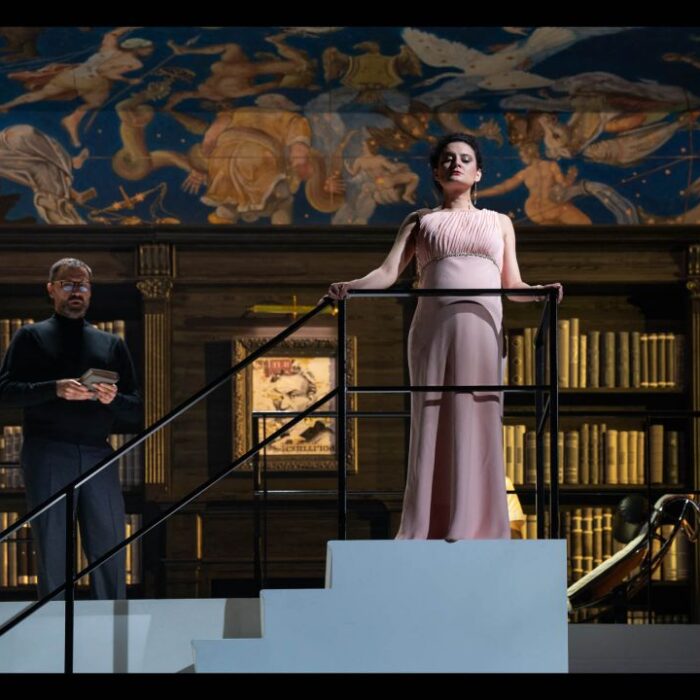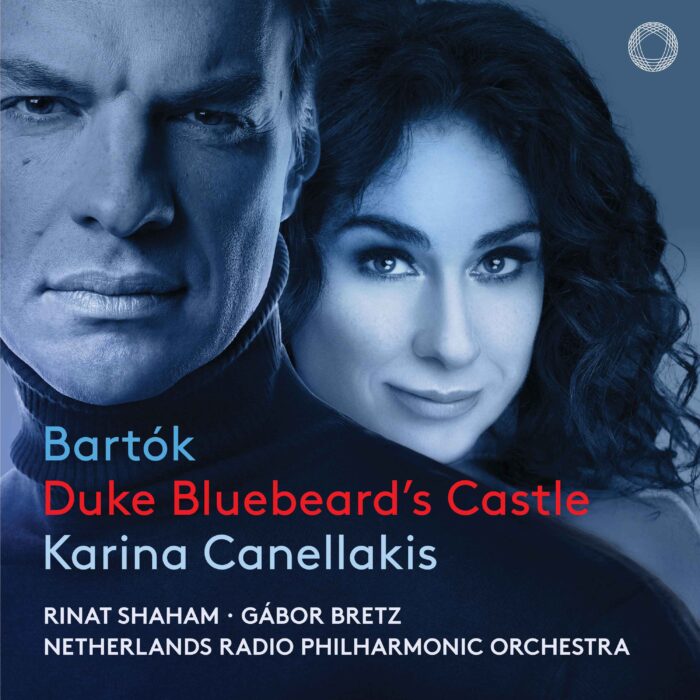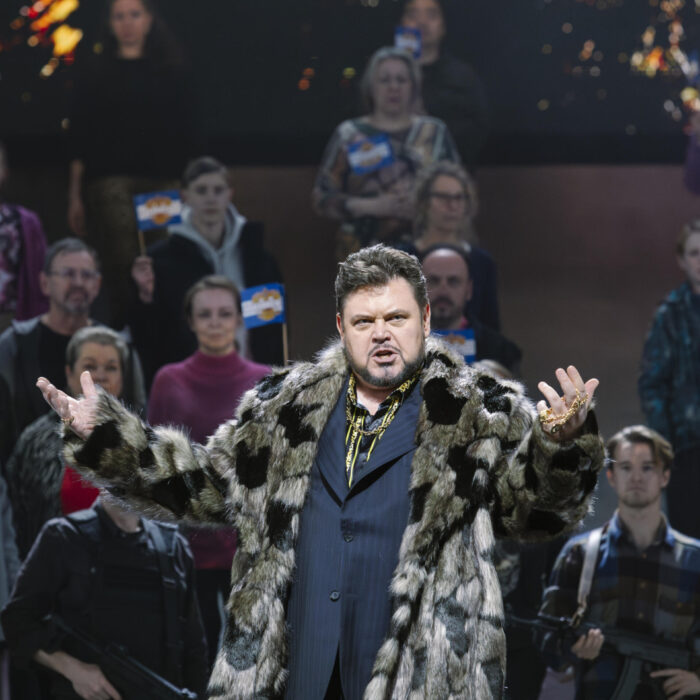
Donizetti Festival 2022 Review: L’aio nell’imbarazzo
Alex Esposito & Alessandro Corbelli Shine in Donizetti Festival’s Sandbox
By Polina Lyapustina(Credits Gianfranco Rota)
This year’s edition of the Donizetti Opera Festival is yet another perfect example of how much diversity there can be in the repertoire of one great Italian composer.
As with every previous year, as I looked at the line-up of three operas chosen for the festival, I was left wondering which one was going to be the must-see performance that would best-encapsulate the festival. With the Bergamo-based festival, you never know what to expect. Will it be brilliant direction that elevates one of Donizetti’s more asinine stories to the level of a masterpiece, as it was with Silvia Paoli’s production of “Enrico di Borgogna” in 2018? Or will we see a new star being born, as happened with Xabier Anduaga, whose triumph in the 2019 Operalia Singing Competition was preceded by his brilliant performance in “Il Castello di Kenilworth”?
Among this year’s performances were the highly anticipated revival of “Chiara e Serafina,” along with one of Donizetti’s shiniest gems, “La Favorite,” performed by an all-star cast. Hot on the heels of these famous pieces, and equally captivating, came “L’aio nell’imbarazzo,” or “The Tutor in a Jam.”
This opera premiered in 1824 in Rome and became one of the first of Donizetti’s operas to achieve wide-spread acclaim, commercial success, and general circulation. Concerning numerous, still relevant, social problems in an endlessly entertaining manner, “L’aio nell’imbarazzo” is opera buffa at its best. Despite this, after two centuries, it is hardly ever staged.
The Approach
Professor Maria Chiara Bertieri reworked the critical edition of the opera, which had a very complex publication history in the 19th century, to balance the story for a modern production. Although the plot is uncomplicated, Donizetti was just 27 at the premiere, and the young and still-inexperienced composer could not effortlessly manage the balance of powers on stage. Bertieri, a scholar at Universita’ degli Studi di Ferrara, streamlined the balance of narrative forces for this new production.
Artistic director of the Donizetti Festival, Francesco Micheli, then took on the project as director. The imperfect lustre of the old piece, unworn to the ears of modern opera lovers, gave Micheli and his team freedom to experiment with their source and see how they could make this old thing shine just as brightly for today’s audience.
Alex Esposito, the tutor of the Bottega Donizetti masterclass, performed here a humorously apt role; that of the titular embarrassed “aio” himself, Don Gregorio, and he brought his students to join him on the stage. Meanwhile, the role of Marquis Antiquati was given to one of the most pre-eminent Italian comic baritones of the 20th century, Alessandro Corbelli. So it was that masters, shoulder to shoulder with their students, and under the direction of Micheli–everyone’s favorite captain for Donizetti’s flagship festival–began to explore the directions in which they could take this novel opera.
The Sandbox
We see a broken-hearted Marquis Antiquati who tries to hide his two sons from the hurts of real life and women, convinced that they cannot handle any romantic relationships until they reach 40. But even though they are locked at home, romance finds a way. Antiquati’s youngest son, Pippetto–played by tenor Lorenzo Martelli–has an entanglement with maid Leonarda–mezzosoprano Caterina Dellaere–while 25-year-old Enrico–tenor Francesco Lucii–is already secretly married to the beautiful Gilda–soprano Marilena Ruta–with whom he has a child. Everything unravels in the best tradition of the opera buffa, with pools of tears, bouts of hysteria, buckets of despair, before, suddenly, a very calm baby appears onstage. What wonderful material already to play with in the sandbox! The creators put an inspired selection of artists into this playground.
The skillful and versatile baritone Esposito led the cast, the old master Corbelli still putting out a powerful performance, the company of young singers, of different levels and qualities, the enthusiastic conductor Vincenzo Milletarì, and a band of brilliant technicians to frame it all according to the director’s vision.
Not everything went smoothly, of course. The story has been moved forward to our near-future, but instead of progress and utopia, we are faced only with the rotten facsimile of the social-networks which we must suffer at present. Unfortunately, many aspects of the performance fell victim to what was ultimately an incomplete realization of this potentially thought-provoking narrative idea. The storyline desperately tried to deviate from this onstage world of flashing screens, and the characters drowned in the mountains of brightly colored scenery, entangled in their own choreographed, ceaseless movements. The original intentions of the creative team and any attempt at critique of a social hierarchy were lost in this endlessly garish and mobile scenery. Maybe our dystopian future is truly destined to be as confusing? Praise must be given, however, to the remarkable work of Belgian lighting designer Peter van Praet, which not only offered technical perfection but helped the cast complete their characters emotionally when dramaturgy and singing failed.
Milletarì conducted with confidence and style, yet he was unable to take full control of the cast, driven as he was by the need to obey the chaotic staging. The orchestra followed him well, and if one closed their eyes for a moment, one could truly enjoy the genius of Donizetti displayed in all its deserved brightness and dignity. The casting was yet another playground of this opera, though its experimentalism opened it up to problems. Contrast between the different degrees of experience between various singers did not play into the hands of quality and consistency, and mistakes happened. It was not that one could say any single singer was untrained, unskilled, or unsuited for their role; yet the differences between performers was conspicuous.
Esposito remained the only vocal powerhouse onstage for any extended period of time. Apart from him, the all-male cast of the Act One sounded flat, and all singers but Esposito struggled to be heard over the orchestra. Neither Lucii, who in general possessed a good handle on his voice and brought an elegant reading of his role, nor Corbelli, though still in great shape, could be on par with Esposito.
Here Comes a Woman
And then, just when one felt fit to lose hope, just as Donizetti had intended: here came a woman to save us all. Marilena Ruta quietly appeared, showing no intention of taking the stage by storm. Soon she showed the real power of her voice and acting, however, and added the ingredient which had been missing from every scene and duet beforehand. Her presence on stage and in the plot clearly showed how the absence of women and their perspectives on problems leaves the ‘male world’ helpless, deaf, and flat.
Not as a ray of hope, but as a shining light of protest, she lit up the stage. Ruta rightly dominated the stage with her ‘secret husband’ Lucii by her side, and she easily challenged even Esposito with her radiant soprano. By the time maestro Corbelli returned to the stage in Act two, not only had his baritone warmed up perfectly–enabling him to reveal his full power by the end of the show–but Ruta faced him down fearlessly and showed her voice had the necessary qualities to stand on stage alongside the master. Her well-balanced soprano and vigorous interpretative skill served the end of the opera perfectly. Gilda takes on the responsibility for solving the central problems of the plot and brings all the matters to a victorious conclusion. Donizetti’s heroine finds familial happiness, and the Gilda of Micheli’s dystopia acquires political power.
The Unnoticed
I had hoped to end my review by praising the genius of the composer, who 200 years ago celebrated and elevated the importance of female participation and responsibility, which are topics as important to discuss, and central to the social conversation, today as ever before. But when the curtain call came, I saw the audience’s reaction to the words sung and the characters played and came to realize that they had all forgotten about Gilda and her brief reign on the stage: or at least, her role was secondary in their enjoyment of this staging. People applauded the loudest for maestro Alessandro Corbelli and for Alex Esposito, who was undoubtedly a hilarious Don Gregorio.
You will not read many reviews of the festival praising Ruta, just as you will not find even a cursory mention of women’s emancipation or responsibilities in the same articles. At best Ruta, who undeniably saved the night, receives only light encouragement alongside the rest of the young performers. The titular character is, after all, the tutor, and Esposito’s performance of Don Gregorio certainly deserves all the praise it is receiving. The picture is solid, and, alas, it is Esposito’s performance which will be remembered in the annals of the festival. But I return once more to the idea of the sandbox: the playground where artists experiment, reviving old masterpieces and going above and beyond in innovation and risk-taking. It is there, I am sure, that the young soprano Marilena Ruta will be encouraged and praised. Praised by her mentor Alex Esposito and her colleagues because, for those onstage, it is skill, ingenuity and determination that saves and makes the night: not titles and pedigree.
I believe that in all the experimenting within the sandbox, the creators of this staging never lost sight of the composer’s deep bow towards women. Broken down to its essential values, divorced from the lineage of the performers onstage, truth and justice are evident in the opera, pronounced and centered on one single person. Who was able to reconcile a broken family, make a career, and breastfeed a baby along the way?
Certainly not Don Gregorio.


